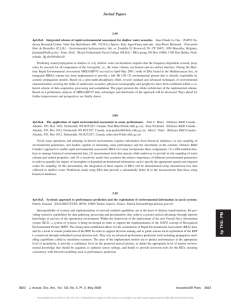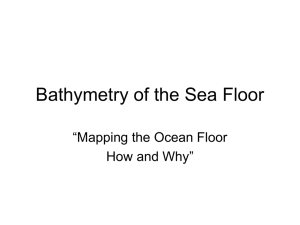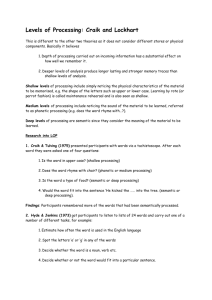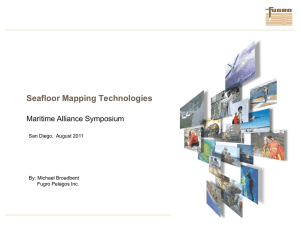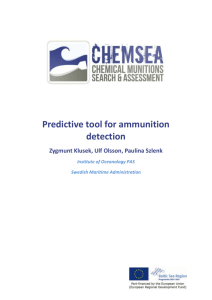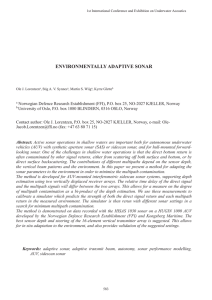An Adaptable Survey Platform for Shallow Water
advertisement
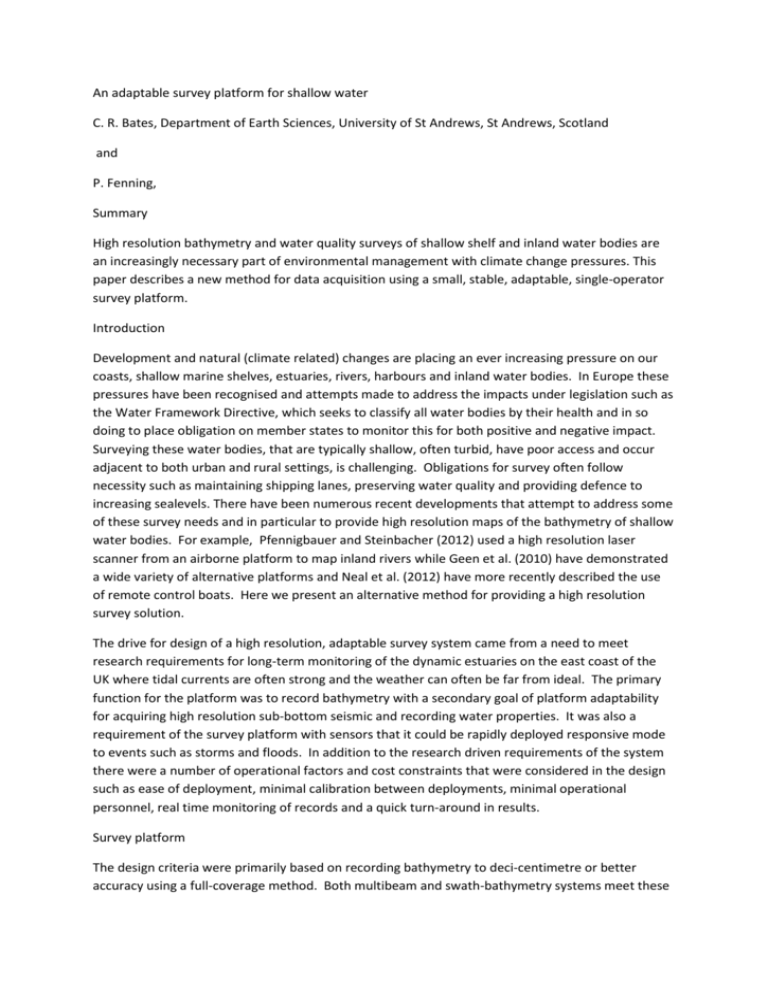
An adaptable survey platform for shallow water C. R. Bates, Department of Earth Sciences, University of St Andrews, St Andrews, Scotland and P. Fenning, Summary High resolution bathymetry and water quality surveys of shallow shelf and inland water bodies are an increasingly necessary part of environmental management with climate change pressures. This paper describes a new method for data acquisition using a small, stable, adaptable, single-operator survey platform. Introduction Development and natural (climate related) changes are placing an ever increasing pressure on our coasts, shallow marine shelves, estuaries, rivers, harbours and inland water bodies. In Europe these pressures have been recognised and attempts made to address the impacts under legislation such as the Water Framework Directive, which seeks to classify all water bodies by their health and in so doing to place obligation on member states to monitor this for both positive and negative impact. Surveying these water bodies, that are typically shallow, often turbid, have poor access and occur adjacent to both urban and rural settings, is challenging. Obligations for survey often follow necessity such as maintaining shipping lanes, preserving water quality and providing defence to increasing sealevels. There have been numerous recent developments that attempt to address some of these survey needs and in particular to provide high resolution maps of the bathymetry of shallow water bodies. For example, Pfennigbauer and Steinbacher (2012) used a high resolution laser scanner from an airborne platform to map inland rivers while Geen et al. (2010) have demonstrated a wide variety of alternative platforms and Neal et al. (2012) have more recently described the use of remote control boats. Here we present an alternative method for providing a high resolution survey solution. The drive for design of a high resolution, adaptable survey system came from a need to meet research requirements for long-term monitoring of the dynamic estuaries on the east coast of the UK where tidal currents are often strong and the weather can often be far from ideal. The primary function for the platform was to record bathymetry with a secondary goal of platform adaptability for acquiring high resolution sub-bottom seismic and recording water properties. It was also a requirement of the survey platform with sensors that it could be rapidly deployed responsive mode to events such as storms and floods. In addition to the research driven requirements of the system there were a number of operational factors and cost constraints that were considered in the design such as ease of deployment, minimal calibration between deployments, minimal operational personnel, real time monitoring of records and a quick turn-around in results. Survey platform The design criteria were primarily based on recording bathymetry to deci-centimetre or better accuracy using a full-coverage method. Both multibeam and swath-bathymetry systems meet these survey conditions and are routinely deployed where water depths are typically less than 10m and currents up to 6kts. The survey platform chosen was a Zego sports boat (Zego Ltd) as it provided a stable platform that could be deployed and recovered by one person on official launch slips but also across beaches or down river banks. It was determined that a survey platform larger than a remote control boat was necessary because of the strong currents often encountered in estuaries and shallow marine settings. The larger platform that would carry an operator also meant that the data being collected could be reviewed in real time thus ensuring that full coverage of the survey area was achieved avoiding the possibility of missing areas and having to return after completion of the survey. It also ensured that real-time decisions were more easily made such as avoidance of hazardous conditions and navigating around complex structures. Another criteria met by the small platform was that the sonar system would be in a permanently calibrated mounting to enable the most rapid deployment. This was easily achieved by the Zego boat where the sonar was mounted on a frame between the two catamaran hulls of the boat (Figure 1). For initial trials a SEA Swathplus 468kHz (SEA ltd.) sonar system was chosen to give maximum swath coverage in the shallow water. Dynamic positioning was achieved through a combination of RTK dGPS positioning with a Topcon HiperPro (Topcon Positioning Systems Inc.) where radio link was maintained with a separately deployed base station. Heading was supplied by a Hemisphere Vector system (Hemisphere GPS) and motion reference by a TSS DMS205 MRU (Teledyne Techonologies) mounted on the sonar head. Critical to surveying in estuaries is the sound velocity as this can rapidly vary with different salinities during flood/ebb tides and this was monitored using a Valeport MinSVP (Valeport) again mounted on the sonar head. All units were controlled and data was recorded by an IP65 rated ruggedized Fox-151 (Aaeon Corp.) on which separate navigation software (Hypack) was used to efficiently manage the survey. A secondary navigation system with a single beam sonar provided additional information including a water temperature log during the survey. Results Two examples are given of half-day surveys using the shallow water craft. The first example is from the tidal estuary reach of the River Avon, east Dorset, UK from Christchurch southeast to its mouth at Hengistbury Head. The estuary is extensively used for maritime recreation with large numbers of both seasonal and permanent moorings. The estuary is typical of many on the south and east coasts of the UK with large shallow sandbanks and mudflat exposed at low tide. The main navigation channel is narrow and can seasonally shallow dependant on winter storm and flood conditions. Typical of small estuaries in the UK, no one authority is responsible for maintaining the navigable channel and therefore no one group have the large finances necessary to undertake traditional routine survey. The Avon experiences a turbid flow with low visibility for most of the estuary due to heavy sediment loads. A base station for the RTK dGPS was established at the north end of the survey grid and radio signal maintained with good strength across the survey to the outer estuary 2.5km distant despite local obstructions including buildings and low hills. The craft was deployed on a small fishing launch ramp and the survey of the main channel (Figure 2) completed in 4 hrs. Figure 2 – swath survey results for the main navigation channel of the Avon and Stour rivers, Christchurh, England. The maximum depth of 5m was recorded at the confluence of the Avon and Stour rivers with the widest part of the navigational channel at approximately 100m, to the south of this where the average depth is only 2.5m. At this place the necessity of conducting the survey using a wide-swath sonar becomes apparent in order to minimise the number of survey lines to cover the area. The second survey example is from Anstruther harbour on the east coast of Scotland. This harbour is typical of many small harbours in the UK that provide moorings using pontoons mainly for pleasure craft with a few commercial vessels such as dive charters, fishing and lobster/crab boats. It is also typical in that resources are not readily available to monitor silting of the harbour on a regular basis for maintaining the navigation channels to full commercial standards. Cost effective solutions of survey are thus desirable. The harbour has an inner part with three pontoons for pleasure craft and an outer part with slipway and a gentle shallows to a sandy beach. The Zego-based bathymetry survey was conducted for the entire harbour and surrounding seawalls over a 2hr period that included launch and recovery of the vessel. Silting of the inner harbour beneath and around the pontoons was clearly mapped as was the main access channel (Figure 3). Figure 3 – swath survey of Anstruther Harbour, Scotland Conclusions The small craft developed for this research project is a versatile platform that meets many of the needs for very shallow, near shore and inland water body surveys. The system is easily deployed by one person and is both rapid in data acquisition and turn-around in processing to final product due to the permanent equipment mounts that require minimal calibration. The current system is routinely deployed together with a RTK dGPS and separate base station. While modern dGPS survey instruments with virtual reference station networks will provide similar, or sometimes better accuracy in surveying without the need for a base station they rely on mobile phone coverage which is not always present throughout the UK. A swath sonar system was chosen for the initial trials in this project as the major investigation sites were estuaries. The system also proved suitable to surveying more complex situations such as harbours with vertical structures however, if this environment was to be the predominant survey sites further tests have shown that the use of a multibeam sonar or one of the newest range of 3D sonar such as Coda Echosope could be a more appropriate choice. The vessel is also capable of carrying different scientific payloads and has been tested for water quality survey with instruments to measure temperature, salinity, ph and has also been fitted for conducting shallow, high resolution sub-bottom sonar surveys with parametric sounders. The Zego thus offers an alternative, cost effective, adaptive survey platform for many shallow water situations. Geen, M. Dobbins, P and Byham, P. 2010 Qualifying Interferometric Sonar Data. Oceanology International, London, 2010 Neal., M., Bates, C. R., Blanchard, T. Hubbard, A. and Woodward, J. (2012). In Press. Field Robotics. A hardware proof of concept for a remote control glacier surveying boat Pfennigbauer, M. and Steinbacher, F. (2012). Hydromapping – High Resolution Shallow Water Mapping from an Airborne Platform. HydroInternational, v. 16, No. 1
